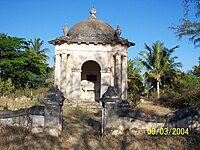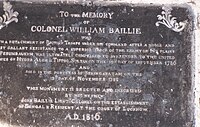
Tipu Sultan, also known as the Tiger of Mysore, was the Indian Muslim ruler of the Kingdom of Mysore based in South India. He was a pioneer of rocket artillery. He introduced a number of administrative innovations during his rule, including a new coinage system and calendar, and a new land revenue system, which initiated the growth of the Mysore silk industry. He expanded the iron-cased Mysorean rockets and commissioned the military manual Fathul Mujahidin. He deployed the rockets against advances of British forces and their allies during the Anglo-Mysore Wars, including the Battle of Pollilur and Siege of Srirangapatna.
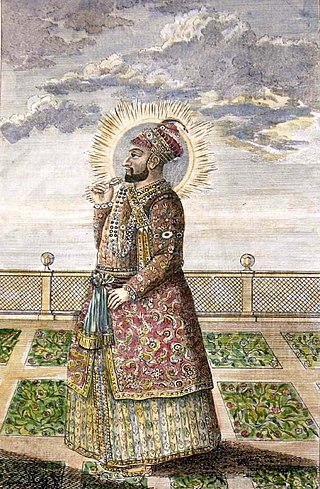
Hyder Ali was the Sultan and de facto ruler of the Kingdom of Mysore in southern India. Born as Hyder Ali, he distinguished himself as a soldier, eventually drawing the attention of Mysore's rulers. Rising to the post of Dalavayi (commander-in-chief) to Krishnaraja Wodeyar II, he came to dominate the titular monarch and the Mysore government. He became the de facto ruler of Mysore as Sarvadhikari by 1761. During intermittent conflicts against the East India Company during the First and Second Anglo–Mysore Wars, Hyder Ali was the military leader.

Srirangapatna is a town and headquarters of one of the seven Taluks of Mandya district, in the Indian State of Karnataka. It gets its name from the Ranganthaswamy temple consecrated at around 984 CE. Later, under the British rule the city was renamed to Seringapatnam. Located near the city of Mandya, it is of religious, cultural and historic importance.
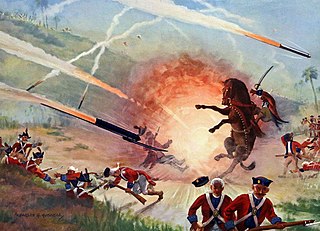
The Battle of Pollilur, also known as the Battle of Polilore or Battle of Perambakam, took place on 10 September 1780 at Pollilur near Conjeevaram, the city of Kanchipuram in present-day Tamil Nadu state, India, as part of the Second Anglo-Mysore War. It was fought between an army commanded by Tipu Sultan of the Kingdom of Mysore, and a British East India Company force led by William Baillie. The EIC force suffered a high number of casualties before surrendering. It was the worst loss the East India Company suffered on the subcontinent until Chillianwala. Benoît de Boigne, a French officer in the service of 6th Regiment of Madras Native Infantry, wrote, "There is not in India an example of a similar defeat".

The Second Anglo-Mysore War was a conflict between the Kingdom of Mysore and the British East India Company from 1780 to 1784. At the time, Mysore was a key French ally in India, and the conflict between Britain against the French and Dutch in the American Revolutionary War sparked Anglo-Mysorean hostilities in India. The great majority of soldiers on the company side were raised, trained, paid and commanded by the company, not the British government. However, the company's operations were also bolstered by Crown troops sent from Britain, and by troops from Hanover, which was also ruled by Britain's King George III.

The First Anglo-Mysore War (1767–1769) was a conflict in India between the Sultanate of Mysore and the East India Company. The war was instigated in part by the machinations of Asaf Jah II, the Nizam of Hyderabad, who sought to divert the company's resources from attempts to gain control over the Northern Circars.

The Anglo-Mysore Wars were a series of four wars fought during the last three decades of the 18th century between the Sultanate of Mysore on the one hand, and the British East India Company, Maratha Empire, Kingdom of Travancore, and the Kingdom of Hyderabad on the other. Hyder Ali and his succeeding son Tipu fought the wars on four fronts: with the British attacking from the west, south and east and the Nizam's forces attacking from the north. The fourth war resulted in the overthrow of the house of Hyder Ali and Tipu, and the dismantlement of Mysore to the benefit of the East India Company, which took control of much of the Indian subcontinent.

The siege of Seringapatam was the final confrontation of the Fourth Anglo-Mysore War between the British East India Company and the Kingdom of Mysore. The British, with the allied Nizam Ali Khan, 2nd Nizam of Hyderabad and Marathas, achieved a decisive victory after breaching the walls of the fortress at Seringapatam and storming the citadel. The leader of the British troops was Major General David Baird, among the lesser known allies were the Portuguese in Goa and Damaon. Tipu Sultan, the de facto ruler after the death of his father, who had usurped the throne of Mysore, was killed in the action. The British restored the Wodeyar dynasty back to power after the victory through a treaty of subsidiary alliance, Krishnaraja Wodeyar III was crowned the King of Mysore. However, they retained indirect control of the kingdom's external affairs.
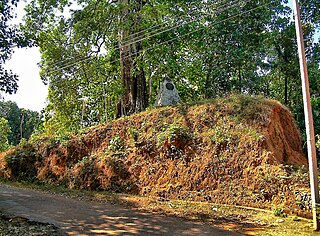
Nedumkotta or Travancore lines was a wall built as a protection against consistent invasions from Mysore during the rule of Tipu Sultan. It was built by the Dharma Raja Karthika Thirunal, King of Travancore, with the request, support and permission of the Kingdom of Kochi. It was constructed by Rama Varma under the supervision of his commander Eustachius De Lannoy. The work was started in 1762 it was completed only by 1775. The lines consist of a ditch about sixteen feet broad and twenty feet deep with a thick bamboo hedge in it, a slight parapet and good rampart and bastions on rising grounds almost flanking each other from one extreme of the lines to the other. The construction of Nedumkotta or the Travancore Lines is considered to be a unique and unparallel episode in Indian History by historians.
The Treaty of Mangalore was signed between Tipu Sultan and the British East India Company on 11 March 1784. It was signed in Mangalore and brought an end to the Second Anglo-Mysore War.
The Captivity of Mangalorean Catholics at Seringapatam (1784–1799) was a 15-year imprisonment of Mangalorean Catholics and other Christians at Seringapatam, in the Carnataca region of India by Tippu Sultan, the de facto ruler of the Kingdom of Mysore. Estimates of the number of captives range from 30,000 to 80,000, but the generally accepted figure is 60,000, as stated by Tipu in the Sultan-ul-Tawarikh. The captivity was the most disconsolate period in the community's history.

Sir Barry Close, 1st Baronet was an army general in the East India Company and a political officer.

James Scurry (1766–1822) was a British soldier and memoirist. He was held captive by Hyder Ali and Tipu Sultan for 10 years (1780–1790) at Seringapatam. He had been kept as a prisoner, first at Bangalore and then moved to the Seringapatnam fort. After his escape from Tipu's army, in Chitterdroog, he reached an English camp. He prepared a narrative of his captivity in 1794, but it was not published until 1824, after his death.
The Captivity of Kodavas (Coorgis) at Seringapatam was the period of capture, deportation, and imprisonment of Kodava Takk speaking Coorgis who rebelled against Tippu Sultan, the de facto ruler of the Kingdom of Mysore, they were caught during a number of attempts to suppress their rebellion in the 1780s.
The Captivity of Nairs at Seringapatam was imposed on the Nairs of Malabar by Tipu Sultan, the de facto ruler of the Kingdom of Mysore from 1786 to 1799. They were subjected to forcible conversions to Sunni Islam, the official religious sect sanctioned by the Ottoman Caliphate, whose approval and alliance was sought by Tippu Sultan. Those who refused conversions had to face many humiliations, hardships, torture, and even death. The Nairs were treated with extreme brutality due to their strong adherence to the Hindu faith and martial tradition. The captivity ended when Nair troops from Travancore defeated Tipu in the Third Anglo-Mysore War. It is estimated that out of the 30,000 Nairs put to captivity, only a few hundred returned to Malabar alive.
The Battle of Pollilur was fought on 27 August 1781, between forces of the Kingdom of Mysore under Hyder Ali and British East India Company forces led by General Eyre Coote. The battle was fought on the site of a 1780 encounter in which a Company force was almost completely routed or captured.

The Gumbaz at Srirangapattana is a Muslim mausoleum at the centre of a landscaped garden, holding the graves of Tippu Sultan, his father Hyder Ali (Middle) and his mother Fakhr-Un-Nisa. It was built by Tippu Sultan to house the graves of his parents. The British allowed Tippu to be buried here after his martyrdom in the Siege of Srirangapatna in 1799.

The Scott's Bungalow is located in Seringapatam on the banks of the river Cauvery, at about half a mile from the Mysore Gate of the Seringapatam gate. The bungalow was the residence of Col. Scott, an officer of the Madras Army who took part in the Siege of Seringapatam in 1799. The bungalow is associated with the legend and tragedy of Col. Scott. The Deserted Bungalow, a poem by Walter Yeldham that was published in 1875, laments the fate of Scott's Bungalow.
John Whitehill was an East India Company officer who was twice as Governor of Madras on a temporary basis in 1777 and 1780.

Colonel Bailey's Dungeon in Srirangapatna was the place where Tipu Sultan, ruler of Mysore Kingdom used to imprison all the British officers who were captured during the Anglo–Mysore Wars fought by him and earlier by his father Hyder Ali. Colonel Bailey, also spelled Baillie, fell into Tipu's hands in the Second Anglo-Mysore War at the Battle of Pollilur (1780), and spent several months in the dungeons of Srirangapatna. It is near the burial memorial of Tipu Sultan and is surrounded by gardens on all four sides. Colonel William Bailey (Baillie) was the only British officer who died in that place in 1782 as he could not sustain the inhuman conditions, and so the dungeon was later named after him. In this context it is said that prisoners were tied to fixtures in the stone slab of the dungeon and were immersed in water up to their necks.






